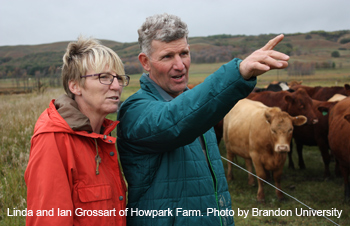Partners in Organic Innovation
A Conversation with Ian Grossart of Howpark Farm
Howpark Farm owners Ian and Linda Grossart are partnering with Dr. Terence McGonigle on Organic Science Cluster II (OSCII) Research Activity A.7: Well-established commercial organic farming: Effect of rate of composted manure application on soil mineral nutrients, yield, and crop nutrient uptake. For more information on this project, please visit http://www.dal.ca/oacc or read our interview with Dr. McGonigle.
 Can you give a brief overview of Howpark Farm?
Can you give a brief overview of Howpark Farm?
We are located 12 miles southeast of Brandon. Our farm was homesteaded by my great grandfather in 1869. My wife and I operate as a partnership. We have three kids who are all in university, who have helped out over time and my dad is still involved with some of the labour.
We have just a little over 2000 acres of total area, and of that, about 800 acres is cropland. Our rotation is usually about a 3 year rotation of alfalfa, then flax, then oats. The oats are usually underseeded with clover, so we have clover the next year as a plow down. After the clover, we go into either rye or wheat, then back into the alfalfa. We also have cattle, but they are all grass finished, so the grain is sold off-farm, but all of the hay from alfalfa is used in our cattle enterprise for feed. We also have free-range broiler chickens in the summer, and we feed them the grain screenings as part of their diet.Ìý
How did Howpark Farm become involved in Organic Science Cluster II and how did you help to shape the research activity?
We’ve worked with Brandon University for years. We have a range of hills here and a lot of native prairie, so for a long time the Botany Department has brought students out to do plant identification. Terry [McGonigle] has brought classes out, and I guess we got talking about what we were doing in organics and he was looking at some research ideas that would work here. So, he is following the first five years of a field that is just into organic, to see what changes happen under organic management with compost application.ÌýÌý
How are you participating and contributing to Organic Science Cluster II?
We’ve contributed a 40 acre field, which is where the research is happening. We have provided the land for the plots; we are doing all of the tillage, all of the seeding and providing the seed. We will do the compost applications, and will provide the compost as well. It’s all work that we normally would do; we have just integrated it into this project.
What excites you the most about the research?
Being able to look at and validate what we are doing within our organic system, and also to find out if there are ways that we could improve our system, like by adding more compost. Hopefully out of this, we will find some other things that we might be able to do rotation-wise. Even just to get to know a little bit more about each step in the rotation, like how much nitrogen is being supplied from our system, is wonderful.
How do you think this research will impact your work, as well as other organic growers?
For our work, as I mentioned above, it’s going to either validate or refute what we’re doing so we can maybe change our program. Other people will also be able to look at our program and the research results, and it may provide them more of a background on what has worked and has not worked here, particularly when it comes to rates of compost. So, I think it is going to be valuable, and beyond just here.
Ìý
For more information on the OSCII activity supported by Howpark Farm, please visit . A print-friendly version of this article is available [PDF -Ìý 250 kB].
The (OSCII) project described in this article is supported by the of 's and . OSCII and this article are collaborative initiatives of the at and the .
